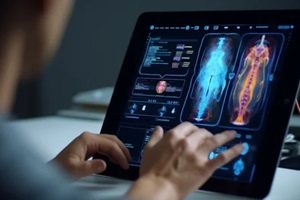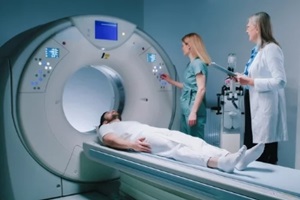Medical imaging solutions made through medical image analysis software are proving to be more important than ever as radiologists constantly find themselves swamped with complex data and an overwhelming workload. To help ease their workload and burden, this article is going to take a closer look at how custom imaging solutions are changing the game for these medical professionals.
We’re going to explore how specialized software isn’t just making their job easier, but it’s also bringing about more accurate and efficient diagnoses.
You’ll get to see how these tailored technologies fit into the unique demands of a radiologist’s day-to-day tasks and how they’re making a real difference in patient care.
From the nuanced needs of individual patients to the broader strokes of healthcare innovation, we’ll uncover the key role these custom tools play in a field that’s at the heart of modern medicine.
The Benefits of Custom Imaging Solutions and Medical Image Analysis Software
 Medical image analysis software stands at the forefront of innovation in healthcare technology, leveraging advanced features and capabilities to tackle the challenges faced by medical professionals, particularly radiologists, in their daily practice.
Medical image analysis software stands at the forefront of innovation in healthcare technology, leveraging advanced features and capabilities to tackle the challenges faced by medical professionals, particularly radiologists, in their daily practice.
Integrating these tools into the medical imaging process directly transforms how radiologists interpret images, diagnose conditions, and plan treatments. At the core of this transformation is the capability for real-time image analysis.
These software solutions are built upon robust AI and machine learning foundations and offer unparalleled efficiency in detecting, localizing, and classifying medical anomalies such as tumors, fractures, and inflammations.
As more data is fed into these systems, they evolve over time, refining their algorithms to further improve accuracy and reliability. This continuous learning process is not just a technical achievement; it represents a significant leap in early disease detection and timely medical intervention, potentially saving lives and improving patient outcomes.
However, the power of a tool lies not only in its technical prowess but also in its usability. Here, custom medical image analysis software truly shines with its user-centric design philosophy.
Medical professionals find these interfaces intuitive and straightforward, enabling them to navigate more complex functionalities easily. This approach to design is crucial, as it minimizes the learning curve and integrates seamlessly into the busy workflow of a radiologist.
The quick load times and responsive nature of these tools mean that medical professionals can dedicate more time to diagnosis and patient care rather than wrestling with software logistics.
Protecting Patient Data
Protecting patient data in healthcare is an essential concern, and the importance of confidentiality and data security cannot be overstated. With this in mind, custom imaging solutions are designed to meet the most stringent regulatory compliance standards.
These tools employ advanced encryption techniques to ensure the integrity and confidentiality of patient data. Adhering to federal and industrial standards, they play a key role in strengthening the trust that underpins the patient-physician relationship.
In addition to robust encryption, these systems are continuously updated to address the latest cybersecurity threats, ensuring the safety of patient information against emerging vulnerabilities. Access control mechanisms are also a key feature, limiting access to sensitive patient data to authorized personnel only.
This multifaceted approach to security, which combines encryption, compliance, and controlled access, offers a comprehensive safeguard for patient data.
Regular security audits further enhance this protection, identifying and mitigating potential vulnerabilities to maintain the highest data security standard. This persistent dedication to securing patient data protects individual privacy and upholds healthcare services‘ integrity and trustworthiness.
Improved Image Format Compatibility
The versatility of these systems is further evident in their high compatibility with existing medical infrastructure. Whether it’s the latest state-of-the-art equipment or legacy systems, these software solutions are designed to integrate smoothly, supporting a variety of medical imaging equipment and standard image file formats such as DICOM, MRC, and NIFTI.
This improved flexibility is important for healthcare facilities, as it allows them to adopt advanced technology without the need for extensive system overhauls, thus saving your organization plenty of time and resources.
Additionally, this compatibility feature ensures a seamless transition and minimal disruption to existing workflows, which is necessary for maintaining continuous patient care and operational efficiency. It also allows healthcare providers to leverage their current investments in imaging equipment, further maximizing the utility and lifespan of their existing resources.
This approach to design, which prioritizes integration and flexibility, demonstrates a deep understanding of the operational realities of healthcare environments, ensuring that these advanced software solutions are not only powerful but also practical and accessible for all types of medical facilities.
Overcoming Challenges with Limited Datasets
One of the challenges in the field of medical imaging is dealing with limited datasets, particularly in the context of rare or unique medical conditions. Custom imaging solutions tackle this challenge head-on, as they’re designed with learning algorithms that maintain optimal performance, even with smaller datasets.
 This capability is imperative to operational efficacy, as it ensures that the software is as effective in diagnosing rare or unique conditions as it is with more common ailments. Furthermore, these advanced algorithms can extrapolate meaningful insights from limited data, an essential factor in rare disease research and diagnosis.
This capability is imperative to operational efficacy, as it ensures that the software is as effective in diagnosing rare or unique conditions as it is with more common ailments. Furthermore, these advanced algorithms can extrapolate meaningful insights from limited data, an essential factor in rare disease research and diagnosis.
By enhancing the software’s ability to learn from limited data, developers are ensuring that even the most unusual and complex medical cases can be analyzed with a high degree of accuracy.
This adaptability broadens the scope of medical conditions that can be effectively diagnosed and ultimately contributes to the advancement of medical knowledge in areas previously constrained by data scarcity.
The Power of AI and ML in Medical Image Analysis Software
The trust and transparency aspect of AI in medical diagnostics cannot be overstated. The so-called “black-box” nature of AI has been a topic of concern among many medical professionals.
To counter this, modern image analysis software is equipped with robust algorithmic explainability features. These features demystify the AI decision-making process, allowing medical professionals to understand and trust the logic behind every AI-driven diagnosis. This transparency is key to fostering acceptance and reliance on AI tools within the medical community.
Addressing skepticism about AI’s role in healthcare is another significant aspect. The developers of these software solutions understand that technology should complement, not replace, the expertise of medical professionals.
This understanding is reflected in the provision of comprehensive training modules and continuous support. Through these initiatives, healthcare providers are reassured that their skills and judgment remain indispensable, with technology serving as a powerful aid.
Unrivaled Client and Software Support
Support for these systems extends beyond their initial deployment. Regular consultations, audits, and ongoing maintenance ensure that the software not only meets the initial needs of a healthcare facility but continues to evolve with it.
These services ensure the software remains secure, up-to-date, and optimized for performance, thereby reducing downtime and enhancing overall productivity.
Additionally, this extended support includes training for medical staff, ensuring they are fully adept at utilizing the software’s capabilities.
Feedback mechanisms are also integral, allowing continuous software improvement based on user experiences and needs. This proactive approach to updating and refining the software ensures that it keeps pace with the latest advancements in medical imaging technology and aligns with the evolving requirements of the healthcare sector.
As a result, healthcare facilities are equipped with a tool that not only performs reliably in the present but is also prepared to meet future challenges.
Unmatched Compatibility
When it comes to custom medical image analysis software development, the possibilities are vast and untapped. Engineers specializing in AI technologies, including deep learning neural networks, work closely with medical professionals to create tailored solutions.
These range from sophisticated 2D and 3D image analytics to intricate organ segmentation and specialized image classifications. Developing these custom solutions is a collaborative process, ensuring that the end product is perfectly aligned with the specific needs of different medical organizations.
These software solutions are not limited to a single medical domain but span across various fields such as oncology, orthopedics, cardiology, and radiology. Their agility and adaptability make them suitable for a wide range of medical imaging needs.
Beyond clinical diagnostics, they extend into clinical trials and research to provide valuable data analytics capabilities, which is absolutely essential in a field as diverse and multifaceted as medicine. The impact of custom medical image analysis software extends beyond the individual practitioner to the broader healthcare ecosystem.
These tools facilitate seamless data integration and information sharing by ensuring compatibility with other applications and systems. This interoperability enhances overall patient care, efficiency, and decision-making in medical practice.
Trust Orases for Your Custom Medical Image Analysis Software
 Integrating custom medical image analysis software in healthcare represents a transformative leap in medical technology.
Integrating custom medical image analysis software in healthcare represents a transformative leap in medical technology.
With features such as real-time image analysis, user-friendly interfaces, compliance with industry standards, and the ability to adapt to both common and rare medical conditions, these systems are not just enhancing the capabilities of medical professionals but are also paving the way for more accurate diagnoses and efficient workflows.
They embody the perfect amalgamation of cutting-edge technology and user-centric design to ensure they not only meet but truly exceed the evolving demands of the healthcare industry.
Moreover, the high compatibility of these systems with existing medical infrastructure makes them a practical and valuable addition to healthcare facilities.
They enable the adoption of advanced technology without necessitating major system overhauls, saving both time and resources. This seamless integration ensures minimal disruption to existing workflows and maximizes the utility of current imaging equipment.
As a leader in custom software development, Orases invites you to explore the transformative potential of custom imaging solutions. To help get you started, we offer a no-obligation, 30-minute consultation to understand your vision and tailor a solution that aligns with your unique needs.
Schedule your consultation today and take the first step towards leveraging the full potential of custom medical image analysis software in your healthcare practice.






